Recently, the Prof. Wang Lei-led research team with the College of Chemistry and Chemical Engineering of IMU has made progress in the research of transfer of photogenerated carrier of semonconductor-BiVO4. The team published in Advanced Energy Materials-an international journal in the field of energy, the article titled“Pt-Induced Defects Curing on BiVO4 Photoanodes for Near-Threshold Charge Separation”(URL:https://doi.org/10.1002/aenm.202102384). IMU is the institution which the first author and corresponding authors of the article are with. Gao Ruiting, a PhD candidate who was enrolled in IMU in 2020, is the first author of the article. Prof. Wang Lei and research fellow He Jinlu who are with the College of Chemistry and Chemical Engineering of IMU and research fellow Tomohiko Nakajima with National Institute of Advanced Industrial Science and Technology, are corresponding authors of the article.
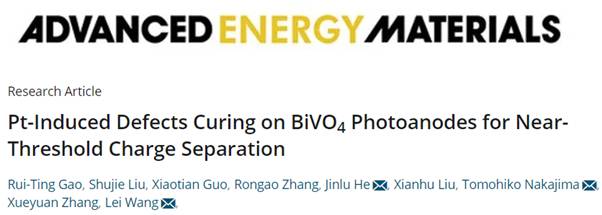
The semiconductor-BiVO4, is one of the important materials in solar-driven photoelectrochemical water splitting for producing hydrogen. This research proposes that through sintering atmosphere intrinsic oxygen vacancy concentration in BiVO4 is regulated to make the semiconductor-BiVO4 have property of activation. Then, with Pt doping, the charge recombination caused by too much oxygen deficiency in BiVO4 is constrained and surface splitting rate at high electric potential is close to 100%. More importantly, the sample of PT: BiVO4 shows the super stability of 50 hours at the electric potential of 0.8 VRHE. This research provides a new path for getting highly efficient and stable photoanodes in designing of solar-driven photoelectrochemical water splitting for producing hydrogen.
Key point 1: Effect of oxygen vacancy concentrations caused by regulation of sintering atmosphere on performance of PEC of BiVO4
During the production of pucherite, the regulation of N2:O2 proportion can cause different oxygen vacancy concentrations in planar BiVO4, increase the conductivity of electrons and adjust the electronic structure of materials to improve the performance of PEC of BiVO4. If pucherite is potentiostatically polarized under light illumination, it is found that the performance of PEC of BiVO4 will be greatly improved if BiVO4 is subject to heat treatment in the atmosphere of N2:O2=5:1. If potentiostatically polarized potentials are further regulated, it is found that onset potentials of curves of photocurrent and voltage after potentiostatic polarization are closely related to polarized voltage, which shows that onset potentials of photoanodes of BiVO4 can be regulated through changes of polarized potentials.
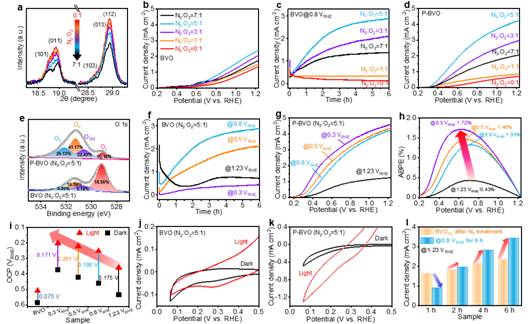
Key point 2: Influence of oxygen vacancy concentration on the transfer of charge carriers
During the potentiostatic polarization, the relationship between oxygen vacancy concentration and life of carriers is discovered in our research. The results of our research show that in the first 6 hours, the performance of photo-electrodes are prominently improved with the increase of oxygen vacancies(2.7 mA cm-2) because some oxygen vacancies are helpful for absorption of OH- in the electrolyte and acceleration of interaction dynamics. From the 6th hour to 20th hour, photocurrent density is relatively stable and after 20 hours the photocurrent density begins to fall slowly. The results of ICP-OES indicate that the dissolution rate of V in the semiconductor is much bigger than the rate of oxygen production on the surface, which results in large quantities of oxygen deficiencies. The EPR test also verifies the conclusion. It is also found that after 45 hours the transient curves of photocurrent of photoelectrode are prominently recombined(i/i0=0.85). The results of IMPS show that after 20 hours transfer rate of charges of the sample does not fall sharply while the charge recombination rate improves sharply. This shows that after 20 hours photogenerated carrier are largely recombined, which causes the decay of photocurrent.
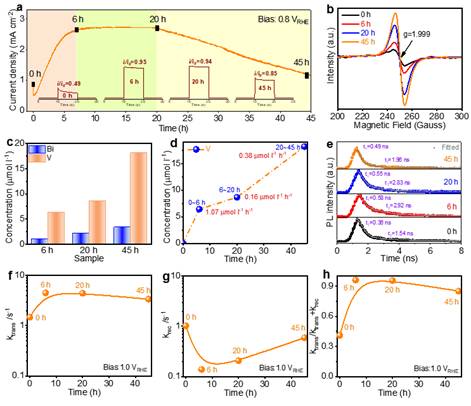
Key point 3: Effect of surface elements on performance of PEC
The intrinsic oxygen vacancies of BiVO4 and those on its surface influence the performance of BiVO4. Besides, the difference in the atomic constituent structure on the surface of BiVO4 also affects the performance of PEC. With different durations of BiVO4 immersed in NaOH, the research team explores the influence of the amount of V on the surface on the potentiostatic polarization. It can be seen that with the increasing proportion of Bi:V on the surface of pucherite, the potentiostatic activation gradually becomes weak and dissolution rate of the material becomes fast. This result shows that besides the intrinsic deficiency of BiVO4, such as oxygen vacancies, the difference in surface elements and structures is also one of the factors influencing the performance of PEC.
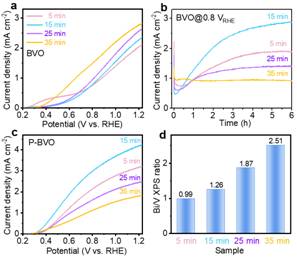
Key point 4: Further improvement of values of ABPE with Pt-doping
Pt-doping further improves the performance of PEC of BiVO4 and onset potential has a negative shift of 60mV. With the potentiostatic activation, the photocurrent density of 5.45 mA cm-2 emerges under the potential of 1.23 VRHE. The solar conversion efficiency is 2.1% if the value of ABPE is 0.65 VRHE. The high photocurrent density under low potential indicates the faster rate of surface kinetics of water oxidation. The surface separation efficiency of P-Pt:BiVO4 is close to 100% under the high potential, which shows that driven by high potential the photogenerated carriers are close to complete separation. The results of IMPS further indicate that the values of ktrans and krec are far lower than P-BVO. The fast separation efficiency shows that Pt-doping accelerates the water oxidation kinetics together with oxygen vacancies.
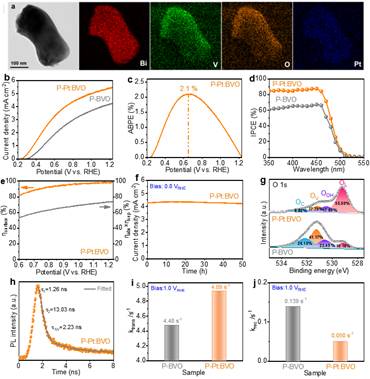
Key point 5: Nonadiabatic molecular dynamics simulation theory of life of charge carriers
Through nonadiabatic molecular dynamics with time-domain density functional theory calculations, it is proved that different oxygen vacancy concentrations and Pt have an effect on life of charge carriers of BiVO4.
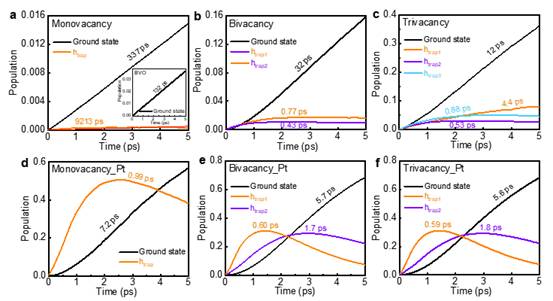
The above research is funded by the National Natural Science Foundation of China, Inner Mongolia Supporting Foundation for Young Excellent Scholars, Inner Mongolia University Supporting Project for Young Scientific Talents and Inner Mongolia University Research-Launching Fund for Newly-Joined Talents.
A Brief Introduction to Wang Lei: Wang Lei is professor and PhD candidate supervisor with the College of Chemistry and Chemical Engineering of IMU. She independently started her research at the college. She has been successively included in Inner Mongolia Autonomous Region “Grassland Talents” Project and Inner Mongolia Autonomous Region Plan for Excellent Young Talents. Since it came into being, her research team has published 16 articles in the journals included in Science Citation Index including Angew. Chem. Int. Ed. (3 articles)、Adv. Energy Mater.、Nano Energy、ACS Catal.、Appl. Catal B(2 articles). One of these articles is listed by ESI as high-frequency cited. IMU is the institution which the first authors of those 16 articles are with.

